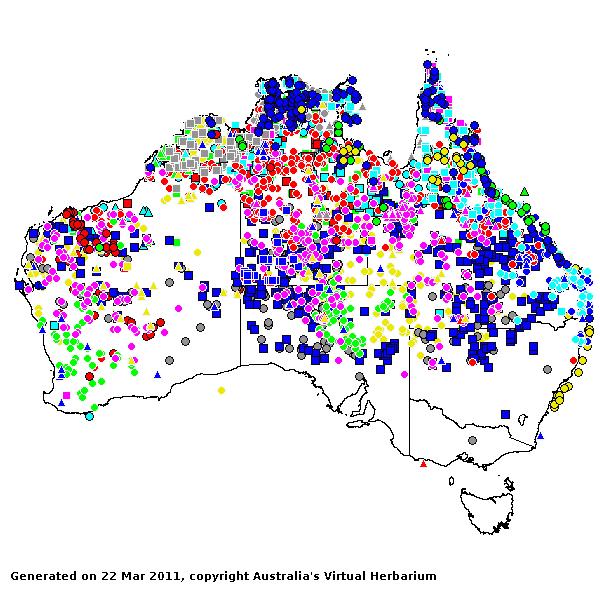Eriachne Prodr. 183 (1810).
Derivation:. From Greek erion (wool) and achne (glume), as the first speies described had hairy glumes.
Taxonomic revisions, nomenclatural references:. M.H.J.Van Eck-Borsboom, Blumea 26: 127–138 (1980); M.Lazarides, Aust.Syst.Bot.8: 355–452 (1995).
Key references (keys and floras):. G.Bentham, Flora Australiensis 7: 626–633 (1878); C.A.Gardner, Flora of Western Australia 1 Gramineae 44–52 (1952); E.E.Henty, Manual Grasses New Guinea 97,100 (1969); M.Lazarides, Tropical Grasses S.E. Asia 163–164 (1980); M.Lazarides, Flora of Central Australia 440–443 (1981); J.C.Tothill and J.B.Hacker, Grasses of Southern Queensland 236–238 (1983); J.P.Jessop, Flora of South Australia 4: 1864–1866 (1986); M.Lazarides and J.Palmer, Flora of the Kimberley Region 1166–1173 (1992); B.K.Simon, Key to Australian Grasses 117–120 (1993); S.W.L.Jacobs and K.L.McClay, Flora of New South Wales 4: 560–562 (1993); D.Sharp and B.K.Simon, AusGrass (2002); K.Mallet (ed.), Flora of Australia 44B: Poaceae 3: 132–175 (2005); J.P.Jessop, Grasses of South Australia 419–424 (2006); S.W.L.Jacobs, R.D.B.Whalley & D.J.B.Wheeler, Grasses of New South Wales, 4th ed, 259–264 (2008).
W.D.Clayton & S.A.Renvoize, Genera Graminum (1986), genus (552).
Native. About 50 species, from China, Indomalayan region and Australia. About 50 species in Australia, WA, NT, SA, Qld, and NSW. Also New Guinea.
Habit. Annual or perennial, rhizomatous or tufted. Leaf blades narrow. Ligule a fringe of hairs.
Inflorescence. Inflorescence paniculate or a single raceme (rarely), a spike-like panicle or an open panicle with branches ending in single spikelets, open or contracted.
Spikelets. Spikelets laterally compressed, 2 flowered or 1 flowered (rarely), with 2 fertile florets, unawned or awned, solitary, pedicelled; with rachilla terminating in a floret. Fertile spikelets disarticulating above glumes.
Glumes. Glumes more or less equal, shorter than spikelet to exceeding florets, shorter than adjacent lemmas or long relative to adjacent lemmas, awned or awnless, keeled (rarely) or non-keeled (usually, rounded on the back), similar (persistent, broad, scarious to subhyaline or cartilaginous). Lower glume 3- 5–13 nerved (-17). Upper glume 3- 5–13 nerved.
Florets. Fertile florets (1–)2. Lemmas similar in texture to glumes to decidedly firmer than glumes (scarious to cartilaginous), becoming indurated to not becoming indurated, entire at apex or incised, muticous or mucronate or awned, 5–7 nerved, hairy (with long white hairs), having margins tucked into palea, 1 keeled to not keeled. Awns when present 1, from a sinus or apical, non-geniculate, much shorter than body of lemma to much longer than body of lemma. Palea entire (pointed) or apically notched, awnless, without apical setae or with apical setae or awned (sometimes with 1 or 2 apical setae or awns), textured like lemma, indurated or not indurated, 2 nerved. Callus short, blunt. Lodicules 2. Stamens (2–)3. Grain small or medium sized or large, ellipsoid, compressed dorsiventrally (plano-convex). Hilum long-linear. Embryo large or small.
Kranz Anatomy. C4, biochemical type NADP-ME (5 species).
Habitat. Savanna. Species of open habitats.
Classification. Micrairoideae; Eriachneae.
Notes. The main genus of the tribe Eriachneae - an awkward little tribe whose embryo structure and indurated lemmas with inrolled margins clearly ally it to Isachneae and Paniceae, but whose combination of bisexual florets, awned lemmas and kranz anatomy points to a direct link with neither (Clayton and Renvoize, 1986). Eriachneae is isolated from other tribes taxonomically and although it has been placed with subfamilies Panicoideae and Arundinoideae, it may deserve placement in a separate subfamily. However, pending further analyses, it is presently placed as Incertae Sedis (Kellogg, pers. comm.).
Types Species. E. squarrosa R.Br.
Biogeographic Element. Clifford & Simon 1981, Simon & Jacobs 1990: Indo-Malayan.


